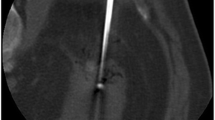Abstract
Purpose
This multicenter phase I/II study evaluated the safety, feasibility, and initial efficacy of radiofrequency ablation (RFA) for small malignant renal tumors.
Methods
Thirty-three patients were enrolled in the study. A single session of RFA was performed in patients with a renal tumor of 1–3 cm in greatest diameter, with the exception of lesions adjacent to the renal hilum. The primary endpoint was the safety of renal RFA, and the secondary endpoints were its feasibility and initial efficacy for local control, as well as the incidence and grade of adverse events. Clinical efficacy was evaluated by CT scans within 1 week and at a further 4 weeks after the procedure using the criteria adapted from the Response Evaluation Criteria in Solid Tumors.
Results
The RFA procedure was completed in 100 % (95 % confidence interval [CI] 89–100 %) of all 33 patients. There were no severe adverse events (0 % [95 % CI 0–11 %]). Among the 33 patients, a complete response, partial response, progressive disease, and stable disease were seen in 28 (85 %), 0 (0 %), one (3 %), and one (3 %) patient(s), respectively, with a tumor response rate of 85 % [95 % CI 68–95 %]). Three patients (9 %), including one ineligible patient (3 %), were not evaluable. Out of 30 evaluable patients, a complete response was achieved in 28 (93 %).
Conclusion
The current multicenter trial revealed that RFA is a safe, feasible, and effective treatment for small malignant renal tumors in patients who are not candidates for surgery.

Similar content being viewed by others
References
Gervais DA, McGovern FJ, Arellano RS, McDougal WS, Mueller PR. Radiofrequency ablation of renal cell carcinoma: part 1, indications, results, and role in patient management over a 6-year period and ablation of 100 tumors. Am J Roentgenol. 2005;185(1):64–71.
Zagoria RJ, Traver MA, Werle DM, Perini M, Hayasaka S, Clark PE. Oncologic efficacy of CT-guided percutaneous radiofrequency ablation of renal cell carcinomas. Am J Roentgenol. 2007;189(2):429–36.
Breen DJ, Rutherford EE, Stedman B, Roy-Choudhury SH, Cast JE, Hayes MC, et al. Management of renal tumors by image-guided radiofrequency ablation: experience in 105 tumors. Cardiovasc Intervent Radiol. 2007;30(5):936–42.
Hegarty NJ, Gill IS, Desai MM, Remer EM, O’Malley CM, Kaouk JH. Probe-ablative nephron-sparing surgery: cryoablation versus radiofrequency ablation. Urology. 2006;68(1 Suppl):7–13.
Veltri A, Gazzera C, Busso M, Solitro F, Piccoli GB, Andreetto B, et al. T1a as the sole selection criterion for RFA of renal masses: randomized controlled trials versus surgery should not be postponed. Cardiovasc Intervent Radiol. 2014;37(5):1292–8.
Kobayashi T, Arai Y, Takeuchi Y, Nakajima Y, Shioyama Y, Sone M, et al. Phase I/II clinical study of percutaneous vertebroplasty (PVP) as palliation for painful malignant vertebral compression fractures (PMVCF): JIVROSG-0202. Ann Oncol. 2009;20(12):1943–7.
Cancer Therapy Evaluation Program, Common Terminology Criteria for Adverse Events Version 3.0. Available from URL: http://ctep.cancer.gov/protocolDevelopment/electronic_applications/docs/ctcaev3.pdf. Accessed Oct 11, 2015.
Therasse P, Arbuck SG, Eisenhauer EA, Wanders J, Kaplan RS, Rubinstein L, et al. New guidelines to evaluate the response to treatment in solid tumors. J Natl Cancer Inst. 2000;92(3):205–16.
Llovet JM, Di Bisceglie AM, Bruix J, Kramer BS, Lencioni R, Zhu AX, et al. Design and endpoints of clinical trials in hepatocellular carcinoma. J Natl Cancer Inst. 2008;100(10):698–711.
Lencioni R, Llovet JM. Modified RECIST (mRECIST) assessment for hepatocellular carcinoma. Semin Liver Dis. 2010;30(1):52–60.
Edeline J, Boucher E, Rolland Y, Vauléon E, Pracht M, Perrin C, et al. Comparison of tumor response by response evaluation criteria in solid tumors (RECIST) and modified RECIST in patients treated with sorafenib for hepatocellular carcinoma. Cancer. 2012;118(1):147–56.
Patel J, Davenport MS, Khalatbari S, Cohan RH, Ellis JH, Platt JF. In vivo predictors of renal cyst pseudoenhancement at 120 kVp. Am J Roentgenol. 2014;202(2):336–42.
Israel GM, Bosniak MA. How I do it: evaluating renal masses. Radiology. 2005;236(2):441–50.
Ahmed M, Solbiati L, Brace CL, Breen DJ, Callstrom MR, Charboneau JW, et al. Image-guided tumor ablation: standardization of terminology and reporting criteria-a 10-year update. Radiology. 2014;273(1):241–60.
Matin SF, Ahrar K, Cadeddu JA, Gervais DA, McGovern FJ, Zagoria RJ, et al. Residual and recurrent disease following renal ablative therapy: a multi-institutional study. J Urol. 2006;176(5):1973–7.
Psutka SP, Feldman AS, McDougal WS, McGovern FJ, Mueller P, Gervais DA, et al. Long-term oncologic outcomes after radiofrequency ablation for T1 renal cell carcinoma. Eur Urol. 2013;63(3):486–92.
Tracy CR, Raman JD, Donnally C, Trimmer CK, Cadeddu JA. Durable oncologic outcomes after radiofrequency ablation: experience from treating 243 small renal masses over 7.5 years. Cancer. 2010;116(13):3135–42.
Levinson AW, Su LM, Agarwal D, Sroka M, Jarrett TW, Kavoussi LR. Long-term oncological and overall outcomes of percutaneous radio frequency ablation in high risk surgical patients with a solitary small renal mass. J Urol. 2008;180(2):499–504.
Acknowledgments
This work was supported by the Health and Labour Sciences Research Grants from the Japanese Ministry of Health, Labour and Welfare.
Author information
Authors and Affiliations
Corresponding author
Ethics declarations
Conflict of interest
HM, KY, TM, HG, and TY reported grants from the Japanese Ministry of Health, Labour and Welfare as mentioned above during the conduct of the study. All remaining authors have declared no conflicts of interest.
Statement of Informed Consent
Informed consent was obtained from all individual participants included in the study.
Statement of Human and Animal Rights
All procedures performed in studies involving human participants were in accordance with the ethical standards of the institutional and/or national research committee and with the 1964 Helsinki Declaration and its later amendments or comparable ethical standards.
Electronic supplementary material
Below is the link to the electronic supplementary material.
Rights and permissions
About this article
Cite this article
Mimura, H., Arai, Y., Yamakado, K. et al. Phase I/II Study of Radiofrequency Ablation for Malignant Renal Tumors: Japan Interventional Radiology in Oncology Study Group 0701. Cardiovasc Intervent Radiol 39, 717–723 (2016). https://doi.org/10.1007/s00270-015-1275-0
Received:
Accepted:
Published:
Issue Date:
DOI: https://doi.org/10.1007/s00270-015-1275-0




